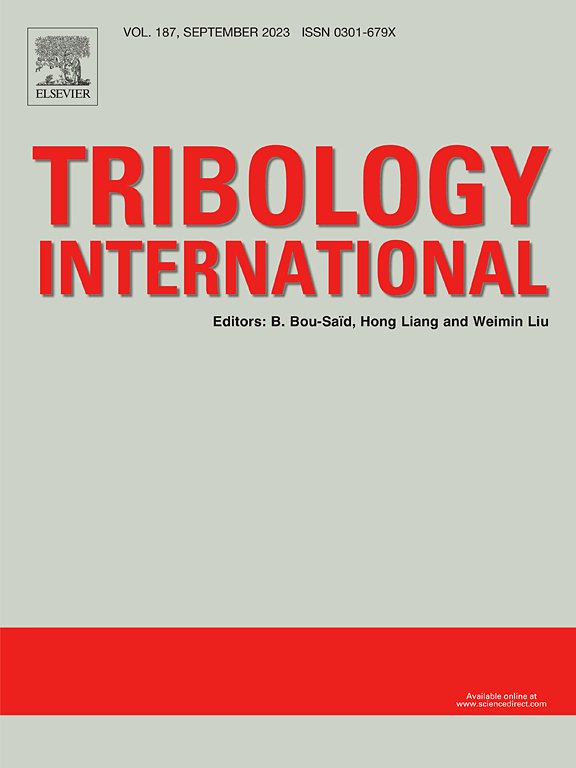Achieving oil-based superlubricity with near-zero wear via synergistic effect between PEEK-PTFE and PAO40 containing DDP-Cu nanoparticles
IF 6.1
1区 工程技术
Q1 ENGINEERING, MECHANICAL
引用次数: 0
Abstract
Oil-based superlubricity introduces a novel approach to energy conservation. Facing two main obstacles at present, i.e., higher viscosity of lubricating oil and special tribopairs, a novel solid-liquid combined system is built in this work, which is mainly based on excellent tribological property of oil-soluble dialkyl-dithiophosphoric-modified Cu nanoparticles (DDP-Cu NPs) and superior self-lubricating capability of polymeric tribopairs. In this system, polyetheretherketone (PEEK) is coupled with polytetrafluoroethylene (PTFE) to form a similar/dissimilar tribopair; and neat PAO40 (a real serving lubricating oil with high viscosity in poly-alpha olefin oil family), or PAO40 containing oil-soluble DDP-Cu NPs (PAO40 + Cu), is used as a lubricant during the sliding test. The results show that only dissimilar tribopair, i.e., PEEK-PTFE, can achieve oil-based superlubricity under the selected sliding conditions, which can be attributed to the synergistic effect between PEEK-PTFE tribopair and PAO40/PAO40 + 0.25 Cu. Furthermore, due to lower cohesive energy density (CED), PTFE is more likely to be transferred onto PEEK together with some tribochemical reactions, finally generating a high-performance tribofilm rich in carboxylated PTFE. In addition, it is concluded that, when lubricated with PAO40, the above synergistic effect is a key to achieve superlubricity; and for PAO40 + 0.25 Cu, the carboxylated PTFE and the exposed Cu core will create chelate effect, which can not only further enhance this synergistic effect, but also improve the wear-resistance of the system reaching near-zero wear. This work not only provides a novel idea for designing oil-based superlubricity system, but broadens the type of tribopair materials achieving oil-based superlubricity to some extent.
通过PEEK-PTFE和含有DDP-Cu纳米颗粒的PAO40之间的协同作用,实现接近零磨损的油基超润滑
油基超润滑为节能提供了一种新的途径。针对目前润滑油高粘度和特殊摩擦对两大障碍,本文主要基于油溶性二烷基二硫磷修饰铜纳米颗粒(DDP-Cu NPs)优异的摩擦学性能和聚合物摩擦对优异的自润滑性能,构建了一种新型的固液复合体系。在该体系中,聚醚醚酮(PEEK)与聚四氟乙烯(PTFE)偶联形成相似/不同的摩擦对;滑动试验时使用纯PAO40(聚α -烯烃油族中真正服役的高粘度润滑油)或含有油溶性DDP-Cu NPs的PAO40 (PAO40 + Cu)作为润滑剂。结果表明,在选定的滑动条件下,只有不同的摩擦对即PEEK-PTFE才能实现油基超润滑,这可归功于PEEK-PTFE摩擦对与PAO40/PAO40 + 0.25 Cu之间的协同作用。此外,由于较低的内聚能密度(CED), PTFE更有可能与一些摩擦化学反应一起转移到PEEK上,最终生成富含羧基化PTFE的高性能摩擦膜。此外,还得出了用PAO40润滑时,上述协同效应是实现超润滑的关键;而对于PAO40 + 0.25 Cu,羧基化聚四氟乙烯与暴露的铜芯会产生螯合效应,不仅可以进一步增强这种协同效应,还可以提高体系的耐磨性,达到接近零磨损。这项工作不仅为油基超润滑系统的设计提供了一种新的思路,而且在一定程度上拓宽了实现油基超润滑的摩擦副材料的种类。
本文章由计算机程序翻译,如有差异,请以英文原文为准。
求助全文
约1分钟内获得全文
求助全文
来源期刊

Tribology International
工程技术-工程:机械
CiteScore
10.10
自引率
16.10%
发文量
627
审稿时长
35 days
期刊介绍:
Tribology is the science of rubbing surfaces and contributes to every facet of our everyday life, from live cell friction to engine lubrication and seismology. As such tribology is truly multidisciplinary and this extraordinary breadth of scientific interest is reflected in the scope of Tribology International.
Tribology International seeks to publish original research papers of the highest scientific quality to provide an archival resource for scientists from all backgrounds. Written contributions are invited reporting experimental and modelling studies both in established areas of tribology and emerging fields. Scientific topics include the physics or chemistry of tribo-surfaces, bio-tribology, surface engineering and materials, contact mechanics, nano-tribology, lubricants and hydrodynamic lubrication.
 求助内容:
求助内容: 应助结果提醒方式:
应助结果提醒方式:


